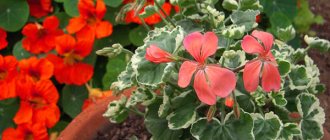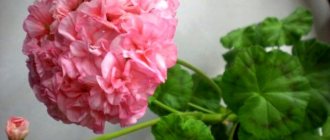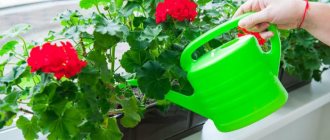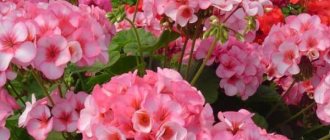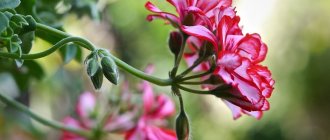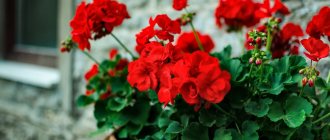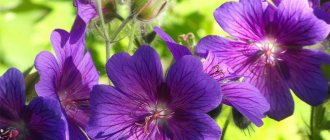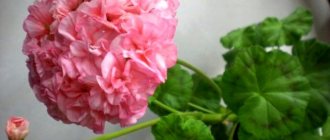In fact, the correct name for this popular houseplant is Pelargonium, but among the people the name “geranium” is firmly attached to it.
True geraniums also exist in nature, many species grow wild in Russia - they can be found in meadows and forests. Both genera belong to the Geraniaceae family, are similar in appearance, and even their names have similar meanings: the word “pelargonium” comes from the Greek “pelargos” - “stork”, and “geranium” is derived from the Greek “geranos” - “crane” . And cranes and storks, as is known, also have external similarities, for example, a beak - it was this that gave the names to the two plants, because their fruit-boxes have an elongated shape and resemble a bird’s beak.
In general, there are many similarities between pelargonium and geranium, but they are still different plants. However, let’s not be boring, and let’s pay tribute to folk traditions - let this home flower be a geranium.
Types and varieties of geraniums (pelargoniums)
There are 280 species of pelargonium in the world (1), but only a few are used in indoor culture.
zonale . She is bordered pelargonium. This type is most often found in apartments. It got its name due to the color of the leaves - they have a darker, often brown stripe along the edge. The leaves are pubescent, with a strong odor. The flowers are collected in large umbrella inflorescences.
Pelargonium is zonal. Photo: pixabay.com
This pelargonium comes from South Africa. It came to Europe at the end of the 17th century and was very popular there for a long time. And so much so that at some point it became a symbol of bourgeois tastelessness. This plant reached Russia only a century later - at the turn of the 18th - 19th centuries. And at first, the beautiful geranium grew exclusively in aristocratic houses. But later everyone began to grow it without exception.
Currently, this pelargonium has more than 10,000 varieties. According to the modern classification proposed by the owner of the English national collection of pelargoniums Fibrex Hasel Kay, zonal pelargoniums are divided into several groups:
- non-double - they have simple flowers with 5 petals arranged in 1 row;
- terry - this includes semi-double varieties with 6 - 8 petals, terry, which have more than 8 petals, as well as tulip-shaped, in which the flowers are semi-double, but they never open - they remain in buds, reminiscent of tulip buds;
- Rosaceae (rosaceae) - with densely double flowers, similar to half-open roses;
- star-shaped (stellar) - their flowers are shaped like stars;
- cactus-shaped - their flowers have long petals, which are sometimes curled into a tube and resemble some cactus flowers;
- variegated (variegated) - they have variegated leaves of various shapes and colors;
- miniature - form very small bushes;
- dwarf - combines all low-growing varieties.
The most interesting and unusual varieties of zonal pelargonium:
- Appleblossom Rosebud - with densely double white, pink-shaped flowers with a pink border and a green center;
- Chelsea Morning - with large snow-white flowers, which have a bright crimson spot at the base of each petal;
- Deacon Peacock - with double orange-red flowers and green-gold foliage with a bronze edge;
- Doreen - with large double peach-pink flowers, which have a white border along the edge of the petals and dark pink veins in the center;
- Icecrystal - with pink-lilac flowers, which have a fuchsia-colored spot at the base of each petal;
- Golden Choice - with dense pink flowers and golden foliage with a red-brown border;
- Green and Gold Petit Pierre - a stunning variety with light green leaves, which has a green spot in the center, bright pink flowers with long petals;
- Joy - with large double flowers of a very unusual color - they are creamy white with a soft pink border along the edge of the petals;
- June Patricia - star-shaped pelargonium with double flowers of orange-red color, with golden leaves;
- Plum Rambler - with densely double flowers of a rose-shaped dark red color with a white underside at the petals.
Ivy-leaved pelargonium (Pelargonium peltatum). Another popular pelargonium and also native to South Africa. People often call it ampelous geranium. It is a trailing plant, but when planted in a hanging pot, it hangs over the edges impressively. The leaves of this pelargonium are glossy, the flowers are collected in umbrella inflorescences and can be of a wide variety of colors.
Pelargonium ivy-leaved. Photo: A. Jagel, globallookpress.com
Among the varieties, the most spectacular ones can be identified:
- Great Balls of Fire Violet Blue - with large semi-double flowers of rich lilac color with crimson veins in the center;
- Great Balls of Fire Merlot - with huge caps of double, rich cherry flowers;
- Temprano Orchid - with double salmon-colored flowers.
Large-flowered pelargonium (Pelargonium grandiflorum). Flower growers often call it the royal geranium. This is one of the most spectacular species - the inflorescences can reach a diameter of 15 cm, and the flowers bloom almost continuously from May to October. They have a variety of colors, there are two-color varieties. This pelargonium also comes from South Africa.
Pelargonium grandiflora. Photo: pixabay.com
She has interesting variety series. For example, Angel are hybrids obtained from crossing large-flowered pelargonium and curly pelargonium (Pelargonium crispum). Their flowers resemble those of violets or bright butterflies. And the leaves smell like lemon. Here are the most popular ones:
- Angel Tip Top Duet - 30 - 40 cm high, the upper petals of the flowers are dark crimson with burgundy veins, the lower ones are pale lilac;
- Angeleyes Bicolor - two-color color: the upper petals are crimson and the lower petals are white;
- Angeleyes Angel Mosquitaway lizzy - with white flowers and a burgundy spot in the center, leaves with a strong lemon aroma.
- Angeleyes Angel Randy - up to 40 cm high with small flowers, up to 2 cm in diameter, light pink in color with a crimson spot and a white edging along the edge of the petals, with a slight aroma of the leaves;
- Wayward Angel - with light lilac flowers with crimson spots on the upper petals.
Another popular variety series is Aristo. It was bred in Germany and is distinguished by its compact bush size and large inflorescences that bloom for 3 months in a row. The most popular varieties:
- Aristo Black Beauty - with burgundy-purple flowers;
- Aristo Candy - the upper petals are purple with a lilac border, the lower petals are lavender with fuchsia spots;
- Aristo Petticoat - lower petals are pure white, upper petals are white with a bright burgundy spot.
Pelargonium grandiflora has several more interesting varieties that are also worth paying attention to:
- Birthday Gir - bright pink flowers with a white base and ruffled edges of the petals;
- Fairy Queen - with large flowers: the upper ones are dark purple with a white edge, the lower ones are white with purple spots and streaks;
- Mona Lisa - with large white and pink flowers and a crimson spot at the base of the petals.
Pelargonium fragrant.
Photo: F. Hecker, globallookpress.com graveolens . This is the same “grandmother’s flower” that grew on the windows of many apartments in Soviet times. Its flowers are not as spectacular as those of other species, but it is not valued for them either. The leaves are what attracts gardeners. They are carved, velvety and very aromatic - with a distinct hint of lemon.
Care for geraniums at home
In general, geraniums can be considered unpretentious, but they have a number of requirements that are important to consider. Grandiflora pelargonium especially likes to show off.
Priming
Any universal soil for flowering plants will do. But it's better to cook it yourself. The ideal option is a mixture of turf, leaf soil and humus in a ratio of 1:1:1 (2).
Temperature
In summer, pelargoniums need to be kept very warm - up to 27 °C, and in winter it should be low - about 14 °C.
It should be remembered that pelargonium does not like cold drafts. Therefore, when ventilating the room, leave the flower away from the open transom. In general, the flower is very loyal to ventilation.
Photo: B. Rainer, globallookpress.com
Lighting
All types of geraniums love plenty of sunlight, so they need to be placed on a well-lit windowsill, periodically turning the pot so that the bush is formed even and regular.
In winter, it is necessary to supplement the geranium with special phytolamps, otherwise the flower may wither. Geraniums need at least 12 hours of full daylight so that the shoots do not stretch.
Humidity
Pelargoniums do not like being flooded, because they come from Africa, and there are often droughts there. Therefore, it is necessary to water moderately; the soil in the pot should dry completely between waterings. In summer, watering should be more abundant - without water, the leaves will fade and the flowers will begin to fly off. But do not allow water to stagnate in the tray; geraniums do not need excess moisture.
They are undemanding to air humidity, but respond well if they are sprayed with soft filtered water from time to time (especially in winter, when batteries dry the air) (so that white stains do not remain on the leaves).
Fertilizers and fertilizers
You can feed geranium much less often than other flowers - once every 2-3 weeks in summer, once every 2-3 months in winter. Fertilizers can be chosen universal or for flowering plants.
Trimming
In the fall, after the geranium has faded, you need to slightly shorten the crown. If this is not done, the geranium will grow into a shapeless bush. Flower growers note: the more you prune geraniums in the fall, the more magnificent they will be in the spring.
And be sure to remove dry leaves and inflorescences.
Common features
Although geranium and pelargonium are not the same thing, in some ways they are very similar, it’s not for nothing that they were called the same for so long. So, the same features of these two colors are as follows:
- Colors. Both geranium and pelargonium have red, white and even lilac flowers, so at first glance it may seem that they are the same.
- The structure of the pistils. After pollination of flowers has occurred, their pistils take on a very similar shape. At one time, this was noticed by Carl Linnaeus. They stretch out a little and acquire a significant resemblance to the beak of a crane or stork (this is also evidenced by the popular name of geranium - cranebird).
- Leaves and stems. Let's start with the stems. In both plants they grow straight, but the leaves alternately extend from the petiole and, in addition, are covered with thin, barely noticeable hairs.
- Aroma. Both plants have a characteristic pleasant aroma.
They do not have any other similar features, however, what they do have is quite enough for inexperienced gardeners to confuse these two completely different species.
Propagating geraniums at home
Green cuttings. Do not throw away the cut tops of geraniums - this is an excellent material for flower propagation. However, cuttings cut in winter most likely will not take root, but those taken in the fall may take root. In general, there are 2 optimal times for cuttings: March and August (3).
Such “crown” plants retain all the properties of the mother plant and begin to bloom in the first summer after rooting. Cuttings usually take root in 2–3 weeks.
Seeds. Geranium is also propagated by seeds, but this is a much more labor-intensive and less effective method. It is better to sow seeds in plastic containers - they are laid out on the surface of the soil without covering them with soil and covered with a lid.
The germination of seeds depends on the initial quality, and this is always a lottery. After the sprouts appear, open the lid and place the container in a well-lit place, water more often, but do not overfill. Additional illumination with phytolamps is a must! Plants from seeds usually bloom within a year.
Transplanting geraniums at home
Photo: Helmut Meyer zur Capellen, globallookpress.com
It is not worth replanting geraniums often, it is stressful for them. There are 2 signs when a flower needs replanting:
- the roots were exposed;
- the geranium began to wither and wither (perhaps it was overwatered, the roots began to rot, so when replanting they will need to be treated with potassium permanganate and dried a little);
Transplant the flower into a pot that is slightly larger than the previous one, carefully transferring it along with a lump of earth. Drainage is a must!
Diseases and pests of geranium
There are several classic problems that arise when growing geraniums.
Gray rot appears on the stems and leaves. Typically, the cause of this problem is overflow.
It is best to remove the flower from the pot, dry the roots, treat them with potassium permanganate and plant the plant in a new pot with fresh soil.
The roots rot close to the ground. This is root rot.
Alas, the plant cannot be saved; it will have to be thrown away.
A whitish coating appears on the leaves. Most likely it is powdery mildew.
For treatment, you can use Fundazol (4) or biological products: Fitosporin-M, Alirin-B, Gamair, Pseudobacterin-2, Planriz.
The leaves curl into a tube, turn yellow and fall off. Examine the reverse side - these could be whiteflies or aphids.
To control pests, you can use the drug Actellik (4).
From the history of plants
In the middle of the 17th century, botanist Johannes Burman (Holland) argued that pelargonium and geranium, the difference between which is obvious, are not related plants. He wanted to separate them into different genera. Nevertheless, Carl Linnaeus, a world-famous naturalist, had by that time compiled his own classification, where he united these plants into a single group. At that time, bright bushes of flowering pelargonium were actively used in landscaping gardens. Flower growers immediately assigned the name to it - geranium.
Popular questions and answers
agronomist-breeder Svetlana Mikhailova about growing pelargoniums and the problems that may arise
Is it possible to grow geraniums in open ground?
Pelargoniums are heat-loving plants; in winter they can only be grown at home. But in the summer it is not only possible, but also necessary to replant them in the garden - there are the most optimal conditions for them. They need to be planted when the threat of spring frosts has passed - after June 10. And in early September, the plants should be dug up, planted in pots and brought into the house.
Why do geranium leaves turn yellow?
Most likely the reason is insufficient watering. In summer, when it’s hot, geraniums need to be watered once every 2–3 days, but make sure that the lump of earth dries out completely. And it is also important that the water in the pot does not stagnate - this leads to rotting of the roots.
Why don't geraniums bloom?
Most likely the roots are too free - geranium blooms profusely when the roots have completely entwined the soil. If there are no flowers, transplant the geranium into a smaller pot.
Sources
- Pelargonium // Royal Botanic Gardens Kew https://powo.science.kew.org/taxon/urn:lsid:ipni.org:names:30302759-2#children
- Visyashcheva L.V., Sokolova T.A. Industrial floriculture. Textbook for technical schools // M.: Agropromizdat, 1991 – 368 p.
- Tulintsev V.G. Floriculture with the basics of selection and seed production // Stroyizdat, Leningrad branch, 1977 - 208 p.
- State catalog of pesticides and agrochemicals approved for use on the territory of the Russian Federation as of July 6, 2022 // Ministry of Agriculture of the Russian Federation https://mcx.gov.ru/ministry/departments/departament-rastenievodstva-mekhanizatsii-khimizatsii- i-zashchity-rasteniy/industry-information/info-gosudarstvennaya-usluga-po-gosudarstvennoy-registratsii-pestitsidov-i-agrokhimikatov/
Main differences
Although pelargonium and geranium are very similar to each other, the differences in differences are quite significant. So, what makes these two species different from each other?
- Habitat. While geranium is a flower often found in nature, its “sister” lives exclusively in homes, under the supervision of flower growers.
- Appearance. This is another difference that may jump out at you. While geranium looks like an ordinary wildflower, pelargonium is a luxurious indoor flower. Its flowers are much larger, and it itself looks more majestic - it is immediately clear that it requires careful care.
- Frost resistance. Considered to be the main difference. Pelargonium grows only in southern countries, so it is not possible to grow it in colder climates. The only option is to place the plant in a warm place when cold weather arrives, otherwise it simply will not survive. Geranium, unlike its southern “relative,” is a much less whimsical flower that can grow even under very unfavorable conditions.
- Flowers and petals. Geranium petals have almost perfect symmetry, and each flower usually has 5 or 8 petals. But its pampered “relative” has symmetry only along one axis.
- Application. The options for using these flowers also differ. Pelargonium, as mentioned earlier, grows mainly in an apartment on the windowsill, but its “sister” is very often planted in flower beds to give the area a more beautiful appearance.
